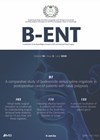
Journal Reviews
A twitch in time with a flicker of knowledge
The middle ear muscles can be seen as one of the ear’s safety mechanisms, and the interplay between eyes and ears has been established; think vestibular ocular reflex (VOR) or semi-circular canal dehiscence (SCCD). But can this protective mechanism be...
Hearing rehabilitation for patients with chronic otitis media
Chronic otitis media (COM) commonly causes associated hearing loss. The authors performed a review of the literature, discussed challenges of restoring hearing in patients with COM and potential future work in reporting results both in terms of hearing outcomes and...
Impact of COVID-19 on ear surgeries
The authors review the impact of the coronavirus pandemic on the practice of ear surgeries in this article. The pandemic has changed how we practise medicine and introduced new guidelines to ensure safety of healthcare personnel. Studies have demonstrated COVID-19...
Steroid use in acute acoustic trauma
Acute acoustic trauma (AAT) injuries include noise-induced damage to inner and middle ear presenting as hearing loss, tinnitus and vertigo. Classic presentation is sensorineural hearing loss with an intact tympanic membrane. The authors carried out a case-control study in military...
Ramifications of the pandemic on acute paediatric mastoiditis: a national UK audit
Acute mastoiditis is a common presentation in the paediatric population across ENT services worldwide. An initial expectation of a rise in the numbers of acute mastoiditis associated with the initial findings of SARS-CoV-2 (COVID-19) virus presence in middle ear in...
Is endoscopic stapes surgery safe and are outcomes comparable to microscopic stapes surgery
Endoscopic techniques for visualisation of the middle ear were described in 1967 by Mer and colleagues, and the use of transcanal endoscopic ear surgery (TEES) has since expanded to a wider range of otologic applications including tympanoplasty and excision of...
International consensus paper on implantable devices for conductive or mixed loss
This is a weighty but insightful ‘Special Feature’ paper in the June edition of Otology and Neurotology. It has the broad aim to gather current opinion from otologists, audiologists, manufacturers and health-economists from around the world on unilateral hearing implantation...
Indication and timing of electrodiagnostic tests in facial palsy
This excellent review describes the benefits and limitations of electrodiagnostic testing for patients with facial paralysis. Tests such as Schirmer, stapedial reflex and electrogustometry have been largely replaced by neurophysiologic tests like nerve excitability test (NET), electroneuronography (ENoG), surface electromyography...
Corticosteroid prescribing in ENT - are we at risk of being sued?
Of medications leading to malpractice claims, corticosteroids comprise the third most common. They are used widely and have a significant side-effect profile: hypertension, lipodystrophy, diabetes, avascular necrosis of the femoral head, peptic ulceration and psychiatric reactions to name but a...
Pharmacological treatment of glue ear in children
Otitis media with effusion (OME), also known as glue ear, is a common cause of hearing loss in children. Most cases resolve spontaneously within three months. Early and proper management of OME can help avoid hearing and speech impairment that...
Cartilage interposition versus PORP ossiculoplasty
In this Egyptian study, the authors looked at the hearing outcomes in patients who underwent ossiculoplasty with cartilage interposition versus those with partial ossicular replacement prosthesis (PORP). They looked at a total of 47 ears from 45 consecutive patients with...
Patients with auto-immune Meniere’s disease more likely to respond to intratympanic steroids
The authors retrospectively reviewed the duration of symptom control after intratympanic dexamethasone (IT) injections in 27 patients with Meniere’s disease (MD) over a six-year period. The patients received two IT injections of 3.3mg/ml of dexamethasone one-to-two weeks apart. Eleven patients...

















